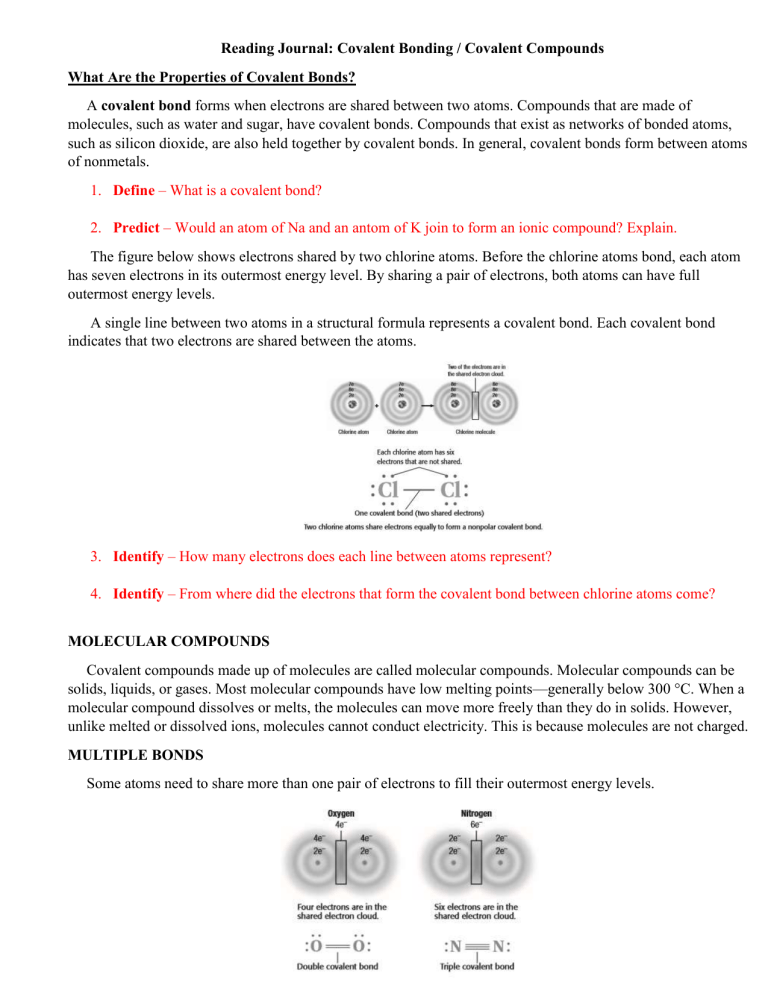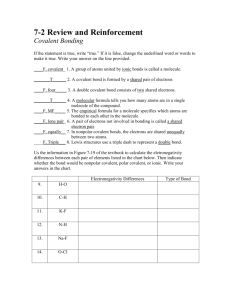File

Reading Journal: Covalent Bonding / Covalent Compounds
What Are the Properties of Covalent Bonds?
A covalent bond forms when electrons are shared between two atoms. Compounds that are made of molecules, such as water and sugar, have covalent bonds. Compounds that exist as networks of bonded atoms, such as silicon dioxide, are also held together by covalent bonds. In general, covalent bonds form between atoms of nonmetals.
1.
Define – What is a covalent bond?
2.
Predict – Would an atom of Na and an antom of K join to form an ionic compound? Explain.
The figure below shows electrons shared by two chlorine atoms. Before the chlorine atoms bond, each atom has seven electrons in its outermost energy level. By sharing a pair of electrons, both atoms can have full outermost energy levels.
A single line between two atoms in a structural formula represents a covalent bond. Each covalent bond indicates that two electrons are shared between the atoms.
3.
Identify – How many electrons does each line between atoms represent?
4.
Identify – From where did the electrons that form the covalent bond between chlorine atoms come?
MOLECULAR COMPOUNDS
Covalent compounds made up of molecules are called molecular compounds. Molecular compounds can be solids, liquids, or gases. Most molecular compounds have low melting points—generally below 300 °C. When a molecular compound dissolves or melts, the molecules can move more freely than they do in solids. However, unlike melted or dissolved ions, molecules cannot conduct electricity. This is because molecules are not charged.
MULTIPLE BONDS
Some atoms need to share more than one pair of electrons to fill their outermost energy levels.
5.
Identify – How many pairs of electrons are shared between oxygen atoms in O
2
?
6.
Identify – How many unshared valence electrons does each oxygen atom have?
Notice that the covalent bond that joins the two oxygen atoms in the figure is shown as two lines. These two lines represent two pairs of electrons, or a total of four electrons. Two pairs of electrons shared between atoms are called a double bond .
The covalent bond that joins the two nitrogen atoms above is shown as three lines. These three lines represent three pairs of electrons. Three pairs of electrons shared between atoms are called a triple bond .
More energy is needed to break double and triple bonds than to break single bonds. A double bond is stronger than a single bond. A triple bond is stronger than both single and double bonds. Double and triple bonds are also shorter than single bonds.
7.
Identify – Which bond is strongest—a single, double, or triple bond?
EQUAL SHARING
When two atoms of the same element share electrons, they share the electrons equally. That is, the electrons spend equal amounts of time near the nuclei of both atoms. For example, two chlorine atoms are exactly alike.
When they bond, electrons are equally attracted to the positive nucleus of each atom. Bonds in which the electrons are shared equally are called nonpolar covalent bonds .
UNEQUAL SHARING
When two atoms of different elements share electrons, they do not share them equally. The shared electrons are attracted to the nucleus of one atom more than to the other. Bonds in which electrons are not shared equally are called polar covalent bonds .
In a molecule of ammonia, NH
3
, electrons are not shared equally.
In general, electrons are more attracted to elements located farther to the right and closer to the top of the periodic table. For example, within a molecule of ammonia, NH3, the shared electrons are more attracted to the nitrogen atom than to the hydrogen atoms.
8.
Explain
–
In a molecule of ammonia, NH
3
, three hydrogen atoms are attached to one nitrogen atom. Are the bonds in ammonia polar covalent or nonpolar covalent? Explain your answer.
What Are the Properties of Covalent Compounds?
1) SOME COVALENT COMPOUNDS DO NOT DISSOLVE IN WATER
Before you use salad dressing, you must shake the bottle to mix the oil and the water in the dressing. The oil and water separate because the oil has covalent compounds that are not soluble in water. Covalent compounds that are not soluble in water contain molecules that are not attracted by water molecules. So, the water molecules stay together and the oil molecules stay together.
9.
Explain
– Why don’t some covalent compounds dissolve in water?
2) COVALENT COMPOUNDS HAVE LOW MELTING POINTS
The forces of attraction between molecules in solid covalent compounds are much weaker than those that hold ionic solids together. It takes less heat to separate the molecules of covalent compounds. So, these compounds have much lower melting and boiling points than ionic compounds do.
3) COVALENT COMPOUNDS DO NOT CONDUCT ELECTRICITY WELL
Most covalent compounds that dissolve in water form solutions that have uncharged molecules. For example, sugar is a covalent compound that dissolves in water. But, it does not form ions. So a solution of sugar and water does not conduct an electric current as shown in the figure below.
However, some covalent compounds do form ions when they dissolve in water. Many acids, for example, form ions in water. Acidic solutions conduct electricity.
10.
Explain – A covalent compound is dissolved in water. The solution does not conduct an electric current.
Why not?
11. Identify – Which of the following substances will conduct electric current: aluminum foil, sugar
(C
12
H
22
O
11
), or potassium hydroxide (KOH) dissolved in water? Explain your answer.









